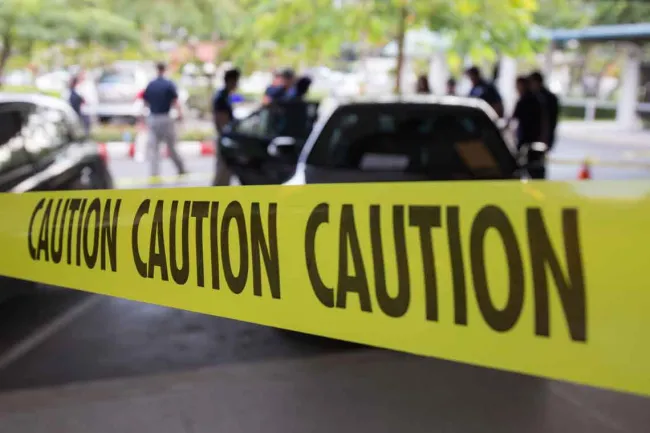June is National Safety Month. This four-week event is observed annually to help people stay safe at home, at work, and on the road. In recognition of this month, we’ve put together some tips to educate readers about major causes of accidents and injury. Today, we discuss gun violence. Stay tuned next week to learn how people are making three injury-prone professions safer.
It’s no secret America likes guns, for better or worse. There are many responsible gun owners out there, but there are also people who get their hands on guns even though they shouldn't. Because of how ubiquitous guns are, one of the weeks of National Safety Month is devoted to gun safety and what to do when there's an active shooter at your work, home, or a public space. Along those lines, here are gun violence facts everyone should know.
1. Most Mass Shootings Occur in the Home (at Least by Some Measures)
There are disagreements about what exactly defines a "mass shooting," but generally they are classified as a shooting with at least four victims — not including the shooter. Some, like the Congressional Research Service, require} that the victims of a shooting be chosen at random for the incident to be classified as a mass shooting. Others, such as Everytown for Gun Safety, an anti-gun violence organization, classify shooting incidents with four or more victims as a mass shooting, even if the shooter knew the victims.
Using the latter definition, Everytown published a report on mass shootings that yielded some unsettling results. The report says 54 percent of mass shooting cases — or around 84 of the 156 analyzed between 2009 and 2016 — were “related to domestic or family violence.” In fact, between those years, 63 percent of mass shootings took place inside private homes, according to the nonprofit.
2. Active Shootings End Very Quickly
Another surprising truth about active shooter situations is they usually end within minutes. In a study of 160 mass shootings between 2000 and 2013, the FBI found that nearly 70 percent of measurable shooting incidents ended in five minutes or less. However, in the chaos of the situation, information can be hard to come by and active shooter situations can seem much longer because of how long it takes for the full story to develop.
Still, we all know a lot of damage can be done in just five minutes, and enduring a life-or-death situation for any amount of time can be harrowing. To better handle these situations, the National Security Council has put together a guide so that everyday people have a course of action if they find themselves in an active shooter situation. This includes tactics like silencing your electronic devices, locking or blocking doors to protect yourself, and leaving your belongings behind.
3. Many Potential Shooters Have Already Been Identified
While the victims of a mass shooting may have been chosen at random, the shooters are known to pose a potential danger to society more often than you think. In fact, in 34 percent of active shooter cases, assailants were already prohibited from possessing a firearm, according to Everytown. That means your local, state, or federal government already identified those individuals as potentially dangerous.
Don’t ignore warning signs from friends and family members. Those signs might not be obvious, either. Threats of violence, violation of protective orders, or substance abuse were seen in a little less than half of eventual shooters, based on Everytown’s research.
4. How to React to an Active Shooter
You don’t have to feel helpless during an active shooter situation. The U.S. Department of Homeland Security has recommended guidelines for what to do when an active shooter is on the loose. In Run, Hide, Fight, the agency says if you know of a safe escape route, leave your belongings behind and RUN from the premises with your hands up in case of law enforcement presence. If you can’t escape, HIDE from the shooter, blocking entry and silencing electronics. As a last resort, FIGHT to incapacitate the shooter and act with deliberate, physical aggression.
So your first instinct should be to leave the premises as quickly as possible. If that's not possible, you can hide in an area you believe is safe and barricade yourself from the shooter. And though putting yourself in danger is never a good idea, when faced with an active shooter both the NSC and the FBI believe fighting may sometimes be your best chance to survive.
Fighting when you have no other choice is more common than you might think. At least 13 percent of the 160 incidents the FBI analyzed ended with unarmed citizens subduing the shooter before law enforcement arrived.
5. Property Owners May Be Responsible for Your Safety
Mass shootings are unpredictable, but businesses and the government can work to stop them. Places of commerce, education, and government facilities made up 80 percent of all shooting locations from 2000 to 2013, according to the FBI's report. All of these entities can do more to protect you.
Installing technology like metal detectors, cameras, and alarms are ways for owners to keep people safe in the face of an uptick in mass shootings. Hiring security guards, managing the flow of visitors, and maintaining a public security presence can also reduce the risk of not just mass shootings, but crime in general.
Your safety is not random. Action can be taken on the part of businesses, schools, and even homeowners to better protect themselves and you from danger. The FBI also stresses your own training and decision-making during these situations, which can make the difference between life or death.
If you or a loved one was attacked and harmed in a public space, you may have opportunities to pursue important changes that can save lives, and compensation for your injuries. Our team of attorneys can help. Contact us today to begin the search for answers, and justice.
